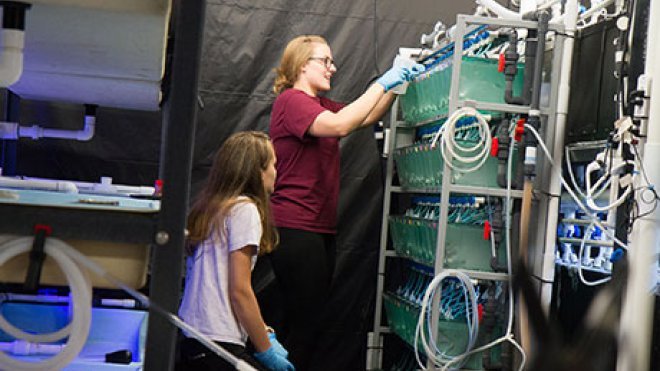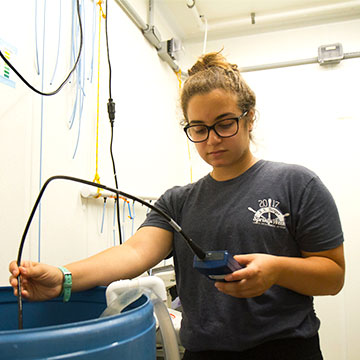RWU Students Capture First, Second Place for Research at World’s Largest Aquaculture Conference
Innovative projects addressing environmental issues earn marine biology majors national recognition

BRISTOL, R.I. – Figuring out what to feed farm-raised trout and salmon might not sound like a big deal, but DaNelle Ellington’s research actually has crucial implications for the planet's health. Erin Gaglias’s experiments with successfully breeding Fire Shrimp in captivity – which isn’t being attempted by any other scientists in the world – would make a major impact on the health of coral reef ecosystems.
As undergraduate researchers in Roger Williams University’s Wet Lab, both students worked at the forefront of innovative research addressing environmental issues – and their hard work has earned them national recognition. Ellington captured first place and Gaglias won second place student poster award at Aquaculture 2019, the world’s largest aquaculture conference and trade show where they outperformed mostly master’s and Ph.D. students to claim the award for best research presentation.

With hands-on learning opportunities as the cornerstone of a Roger Williams education, RWU empowers students to undertake deep research projects and gain valuable skills and experiences in their undergraduate programs.
For a year and a half, Ellington, a senior marine biology major, has been investigating a new, sustainable solution to feeding fish farmed for human consumption, other than more fish. In collaboration with Boston-based biotech company KnipBio, RWU aquarium systems & design research associate Joe Szczebak, RWU Senior Aquarist Casey Murray and Associate Professor of Marine Biology Andrew Rhyne, Ellington has been running experiments on feeding various strains of bacteria to trout in the Wet Lab.
It takes an unsustainable amount of fish meal to nourish trout that feed the human population – an average of 1.9 kilograms of wild-harvested fish for every 1 kilogram of fish raised on compound feeds, according to Ellington and her research sources.
The basis of their experiments is a single-cell protein – but beyond that, it’s so groundbreaking that we can’t tell you what it is.
“Fish are a major source of protein for the human population, and we’re growing and must keep up with the demand for a protein source,” she said. “With essentially a 2-1 ratio, that’s a huge amount of fish we’re taking out of the ecosystem just to feed our food source. If this becomes mainstream, it would have a huge impact on our planet.”
Gaglias’s project required all of her skills from marine biology to aquaculture and aquarium science, transforming her into a scientist and engineer as she investigated the optimal conditions for the Fire Shrimp’s growth, designed and built the aquarium systems in which the crustaceans lived during her experiments.
A vital player in the health of coral reef ecosystems, the fire-engine-red crustaceans are highly sought after for hobbyist’s tanks and with all captured from the wild, evidence suggests their species are being exploited, Gaglias said.
Rearing them from larvae to adults, Gaglias experimented with optimizing the shrimp’s first feedings, salinity and temperature levels for successful aquaculture.
“If we can optimize the process for aquaculture in a lab, they can be raised on a larger scale, which would mitigate the need for taking them from the wild,” she said. “This isn’t just scientific research – it was also a cool engineering project. You have to be a carpenter and you have to be a plumber. I even make my own saltwater because the shrimp need a specific salinity.”